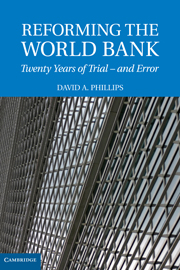Book contents
- Frontmatter
- Contents
- Preface: The Search for Effectiveness in the World's Premier Development Institution
- REFORMING THE WORLD BANK
- PART I ORIGINS AND EVOLUTION
- PART II THE SEARCH FOR EFFECTIVENESS
- PART III TOWARDS REAL REFORM: THE GOVERNANCE AGENDA
- 10 The Governors and the Directors
- 11 The Leadership
- 12 Looking Back and Looking Forward: What Is to Be Done?
- Index
10 - The Governors and the Directors
Published online by Cambridge University Press: 25 January 2011
- Frontmatter
- Contents
- Preface: The Search for Effectiveness in the World's Premier Development Institution
- REFORMING THE WORLD BANK
- PART I ORIGINS AND EVOLUTION
- PART II THE SEARCH FOR EFFECTIVENESS
- PART III TOWARDS REAL REFORM: THE GOVERNANCE AGENDA
- 10 The Governors and the Directors
- 11 The Leadership
- 12 Looking Back and Looking Forward: What Is to Be Done?
- Index
Summary
SHOULD GOVERNANCE HAVE BEEN A PART OF THE REORGANIZATION?
The extent of the deficiencies of the reorganization raises questions about the stewardship of the Bank. Should the governors and the directors have exercised greater control over events? To what extent were they responsible for the missteps? To what extent were their actions consistent with their fiduciary obligations? What are the implications of the style of governance for getting the organization on to a satisfactory path toward effectiveness?
The Strategic Compact was drawn up between the president and the board of executive directors. As we have seen, it was not a carefully planned initiative, but originated as a way of getting the board to increase the budget and was then broadened out into a reform program. Within this reform program, the critical dimension that was not ‘on the table’ was governance itself. Understandably, the Compact did not require its signatories to subject themselves to its discipline. Neither the board of directors nor its secretariat was expected to change processes or to reduce expenditure. In fact, the life of the board seemed to remain unaffected by the churning that was taking place in the organization over which it had oversight, despite the fact that the board members worked every day in the same building as the people over whom they had responsibility.
The fact that the Strategic Compact did not address the Bank's own governance meant that it was, rather, looking down inside the organization to identify the problems and find the solutions, that is, looking to the organization's management and employees – structure, capacities, and attitudes.
- Type
- Chapter
- Information
- Reforming the World BankTwenty Years of Trial - and Error, pp. 227 - 262Publisher: Cambridge University PressPrint publication year: 2009

